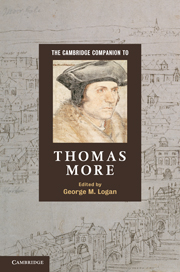Book contents
- Frontmatter
- Part I Life, times and work
- Part II Five Major Works
- 7 Reading Utopia
- 8 More on tyranny: The History of King Richard the Third
- 9 ‘The comen knowen multytude of crysten men’: A Dialogue Concerning Heresies and the defence of Christendom
- 10 ‘In stede of harme inestimable good’: A Dialogue of Comfort against Tribulation
- 11 The Lessons Of Gethsemane: De Tristitia Christi
- Part III Reception
- Foundational resources for More studies
- Index
11 - The Lessons Of Gethsemane: De Tristitia Christi
from Part II - Five Major Works
Published online by Cambridge University Press: 28 May 2011
- Frontmatter
- Part I Life, times and work
- Part II Five Major Works
- 7 Reading Utopia
- 8 More on tyranny: The History of King Richard the Third
- 9 ‘The comen knowen multytude of crysten men’: A Dialogue Concerning Heresies and the defence of Christendom
- 10 ‘In stede of harme inestimable good’: A Dialogue of Comfort against Tribulation
- 11 The Lessons Of Gethsemane: De Tristitia Christi
- Part III Reception
- Foundational resources for More studies
- Index
Summary
DATE, CIRCUMSTANCES AND HABITS OF COMPOSITION
De Tristitia Christi, an unfinished commentary on the agony of Christ in the Garden of Gethsemane, is the last of Thomas More’s major works, composed while he was imprisoned in the Tower of London on a charge of misprision of treason. According to the preface to the work which William Rastell supplied for its first translation – by More’s granddaughter, Mary Basset, in the 1557 edition of the English works – More began De Tristitia ‘beyng then prisoner, and coulde not atchieue and finishe the same’ because he was ‘bereaued and put from hys bookes, pen, inke and paper’ (1557 sig. QQ7v; CW 14:1077–8). On the basis of this information, we can place the composition of the work sometime between April 1534, when More was taken prisoner, and June 1535, when his books and writing materials were confiscated by the royal authorities (see above, 128). Such circumstances as these are enough to stimulate interest in the work’s composition and content, but we are also fortunate that More’s manuscript has survived, having been found in 1963 at the Royal College of Corpus Christi in Valencia, Spain, and analysed in detail by Clarence H. Miller in the Yale editon of De Tristitia (CW 14:695–724). The only surviving holograph of a major work by More, the Valencia manuscript affords a rare glimpse into his methods and process of composition, if not in general, at least under the straitened circumstances of his imprisonment.
The Valencia autograph (reproduced in the Yale edition as a facing-page facsimile with Miller’s transcription and translation of the Latin text) leaves an impression both of the urgency of More’s circumstances and of the privations of his Tower cell. As Miller shows, More composed quickly, revising as he went, crossing out what he wished to change and making interlinear additions with carets (CW 14:745–54).
- Type
- Chapter
- Information
- The Cambridge Companion to Thomas More , pp. 239 - 262Publisher: Cambridge University PressPrint publication year: 2011

